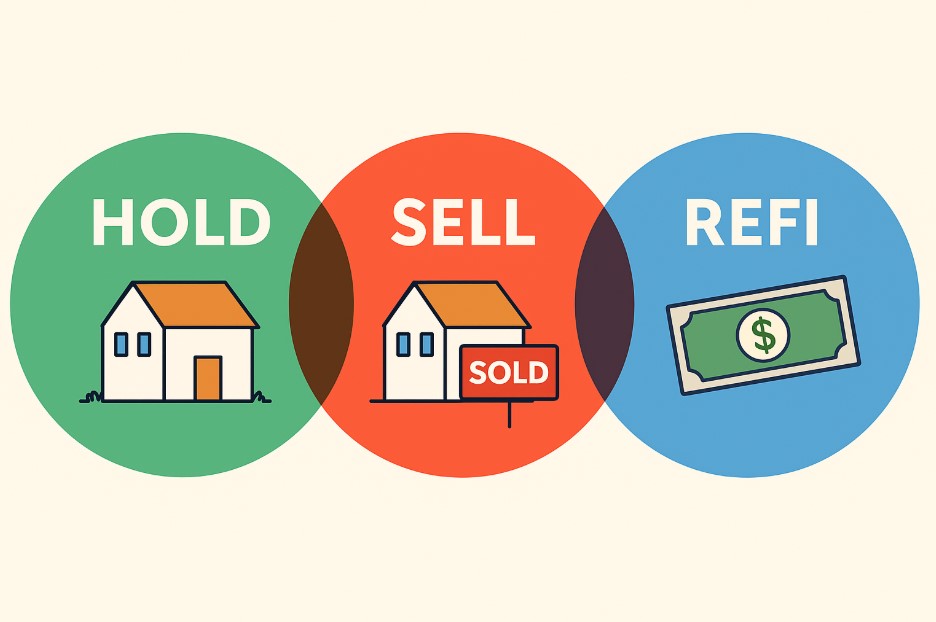Real Estate
Hold, Sell, or Refi: How Smart Investors Decide Their Next Move

When you own a rental property, you eventually face the question: should you hold, sell, or refinance? Each choice carries different financial outcomes, and the wrong move can limit growth. The right one can accelerate it. Smart investors know that the decision isn’t about guessing the market – it’s about weighing real factors tied to performance, debt, taxes, and long-term goals.
Why the Decision Matters
Rental property isn’t just an asset you park and forget. Cash flow, appreciation, and debt terms change over time. Equity builds up, tenants move in and out, and interest rates shift. If you’re running numbers, ignoring the decision to hold, sell, or refi means you could be leaving thousands on the table. Worse, you could be exposing yourself to risks you didn’t plan for.
The Brrrr Method – Buy, Rehab, Rent, Refinance, Repeat – relies heavily on making the right refinancing moves at the right time. But even if you aren’t following Brrrr to the letter, every investor should know when it makes sense to hold, when it makes sense to exit, and when tapping into equity through a refi is the smarter call.
When to Hold
Sometimes the best move is no move. Holding makes sense when your property is stable and producing the kind of returns you projected. Cash flow is strong, tenants are consistent, and the property requires minimal upkeep. If rents are rising in your area and you have favorable financing, holding allows you to keep stacking equity while building a steady income.
But holding comes with conditions. You should evaluate whether the return on equity (ROE) still justifies tying up capital. A property bought five years ago might have doubled in value, but if that appreciation means your cash flow percentage has shrunk relative to the equity, holding might not be the most efficient use of funds.
In simple terms, holding is smart if the property is still pulling its weight. If not, your capital might be better deployed elsewhere.
When to Sell
Selling can be uncomfortable for investors who love long-term holds, but sometimes it’s the right play. One major factor is market timing. If property values in your area have peaked and rental demand is softening, locking in gains through a sale can protect you from downturns.
Selling can also be a tax decision. For example, if you qualify for a 1031 exchange, you can roll profits into another property without paying capital gains taxes immediately. That lets you trade into a bigger or more profitable investment. On the flip side, failing to plan for taxes can erase a big chunk of your gains.
Operational headaches can also push you toward selling. If tenant turnover is high, repairs are constant, or the property no longer fits your investment goals, offloading it might free up bandwidth and capital.
A final point: selling doesn’t always mean cashing out permanently. Some investors sell to rebalance portfolios, reduce risk in a specific market, or move into properties that align better with their strategy.
When to Refinance
Refinancing is a middle path between holding and selling. You keep the property but restructure the debt. This makes sense when you’ve built significant equity or when market rates shift in your favor.
Refinancing through the Brrrr Method is a deliberate step: you rehab, rent, and then refi to pull capital back out. Done correctly, you can recycle your original investment into another property without losing ownership of the first.
Beyond Brrrr, refinancing is smart when you can lower your interest rate, extend the loan term to improve cash flow, or access equity for reinvestment. But caution is required. If cash-out refinancing reduces your cash flow to a fragile margin, you may be taking on unnecessary risk.
Also, pay attention to fees. Closing costs and lender requirements can eat into benefits if you don’t run the math carefully. Refinancing only makes sense when the long-term gain outweighs the short-term expense.
Mistakes Investors Make
Some investors hold too long. They ignore declining ROE and tie up capital in properties that could be traded for higher-yielding ones. Others sell too early, chasing quick profits but missing out on steady long-term cash flow. Then there are those who refinance without stress-testing the new loan terms, only to find themselves overleveraged.
The key mistake across all three decisions is failing to revisit the numbers. Real estate is dynamic. Market conditions, property performance, and financing terms don’t stay static. If you’re not reevaluating annually – or even quarterly – you risk making decisions based on outdated assumptions.
How Market Conditions Influence the Choice
Interest rates directly affect the refinance option. If rates are high, refinancing may wipe out cash flow instead of boosting it. Conversely, low rates open opportunities for pulling equity at minimal cost.
Housing supply and demand trends affect hold and sell decisions. A tightening rental market favors holding, while oversupply and slowing demand can tip the scales toward selling.
Inflation also plays a role. Properties are tangible assets that can hedge against inflation, but higher expenses can erode net income. The right decision depends on whether your property is positioned to handle those shifts.
Making the Right Call – Hold, Sell, or Refi in Today’s Real Estate Market
In the current environment, investors should be especially cautious about debt structures. Rates have climbed compared to just a few years ago, which makes refinancing less attractive unless you’re unlocking capital for a clear growth play. Holding is often safer if your financing is locked at a low rate and rental demand in your market is strong.
Selling has become more appealing in overheated markets where appreciation has already run ahead of fundamentals. Locking in equity gains now can protect you from corrections. But selling also has opportunity costs – namely, losing future rent and appreciation.
There’s no one-size-fits-all answer. Each move requires evaluating ROI, cash flow, tax exposure, and future plans. The smartest investors don’t guess. They model scenarios and base decisions on numbers.
The Benefits of Partnering with an Investment Loan Company
For newer investors, making the hold, sell, or refi decision can be intimidating. Partnering with a real estate investment loan company like Brrrr Loans gives you access to experts who understand the nuances of leverage, cash flow, and growth. These companies specialize in funding each stage of the Brrrr Method and can provide insights on whether refinancing is realistic, how to structure debt, and when it makes sense to keep capital tied up versus pulling it out. If you want a deeper dive into how these strategies connect, Brrrr Loans has written about smart ways to fund each step of the method here.
Final Thoughts
The decision to hold, sell, or refinance isn’t about gut feelings – it’s about math and strategy. Investors who revisit their numbers regularly are better equipped to maximize returns and avoid missteps.
Hold when the property is stable, profitable, and fits your plan. Sell when gains outweigh future potential or when the property no longer aligns with your goals. Refinance when the numbers justify pulling equity or reducing debt costs.
Making the right call is what separates investors who just own properties from those who build lasting wealth.














